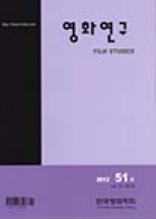- 영문명
- On the Expressionistic Characteristics of The Passion of Joan of Arc
- 발행기관
- 한국영화학회
- 저자명
- 김영혜
- 간행물 정보
- 『영화연구』제50호, 111~136쪽, 전체 26쪽
- 주제분류
- 예술체육 > 예술일반
- 파일형태
- 발행일자
- 2011.12.31
5,920원
구매일시로부터 72시간 이내에 다운로드 가능합니다.
이 학술논문 정보는 (주)교보문고와 각 발행기관 사이에 저작물 이용 계약이 체결된 것으로, 교보문고를 통해 제공되고 있습니다.

국문 초록
영문 초록
This article is a study on the Expressionistic characteristics of C. Dreyer's eminent film, The Passion of Joan of Arc(1928). Though The Passion is generally categorized as an Expressionist film, many film critics and scholars see the film as a wonderful combination of 1920s' popular European film styles--French Impressionism, Russian Montage films and German Expressionism. My purpose of this article is not to trap the film into one concrete category but to understand for what artistic purpose Dreyer used the Expressionistic elements most strongly in the film. This understanding leads to the further analysis on André Bazin's severe criticism on the Expressionist films, especially (Robert Wiene, 1919). Bazin insists that the film did all possible violence to images with painted and distorted set decoration and unnatural lightings. For Bazin, film is destined to represent natural reality or at least a plausible reality which an audience can recognize as what they know in reality. Panofsky also criticizes , saying that the film pre-stylized our reality before it faces the reality as it is. The ground what Bazin and Panofsky's criticism steps on is that film was born out of photography, a technology which records realty as it is. According to this position, it is not surprising that psycho dramas like or scientific films like Méliès's are treated as 'failures' because these films use artificial background and lighting to express 'what is invisible' or 'what does not exist'. However a lot of films have human being's emotion, imagination, inner conflict, state of mind, dream or fantasy as its main subject matter. If film makers who are interested in these subject matters are restricted in filming outside world as it is, it would be the same thing as to put them in fetters. Camera records whatever it is in front of it. Camera does not make difference between natural reality and artificial reality. Film history is divided into two clearly separated styles, realistic and expressionistic style. Both deserve proper appreciation for their own virtue and beauty rather than disparaged on the basis of one of two positions.
목차
1. 들어가는 말
2. <열정>의 표현주의적 스타일 분석
3. 표현주의 영화에 대한 바쟁의 비판에 대하여
4. 마무리
해당간행물 수록 논문
- 일제 강점 말기와 유신 정권 시기의 국책선전영화 비교 연구
- 유신체제기 한국영화 <증언>(1974)의 영화적 특징과 시대적 특수성
- 조선영화 태동기의 일꾼 이구영의 영화인생론
- 쇼트/역쇼트에 대한 지각심리학적 접근
- 영화제작에 사용되는 모션과 페이셜 캡쳐 연구
- 열린 아시아, 닫힌 민족주의
- 리아 타지리의 영화 <역사와 기억>에 대한 연구
- 일상적 현실에 대한 풍자와 비판, 창작수법의 혁신, 체코슬로바키아 영화(1963-1968)
- 인터랙티브 알고리즘에 기반을 둔 다양한 영상 실험과 미학
- 부산영상산업 발전방향 타당성 연구
- ‘한국영화 르네상스’(1997~2006)의 동역학에 대한 연구
- 다큐멘터리영화의 관객소통 방식 연구
- 경북 영화산업 활성화 방안
- <잔 다르크의 열정>의 표현주의적 성격에 대하여
- 남자, 몸, 폭력 그리고 이산(離散)정체성의 정치학
- 대안적인 다큐멘터리 스타일: 장르 컨벤션의 활용
- 아리스토텔레스의 ‘시학’을 통해서 본 영화의 대중성 연구
- 관계론적 입장에서 바라본 탈 중심 공간의 시각이미지 표현 방법 연구
- <써니>를 통해 본 복고 이미지와 환각적 기호로서의 향수에 관한 연구
참고문헌
관련논문
예술체육 > 예술일반분야 BEST
- 생성형 AI 도구와 디자이너의 협업 프로세스 개발 - 이미지를 통한 아이디어 확산에서 고해상도 렌더링까지
- 영화 [올드보이]와 소포클레스 「오이디푸스 왕」의 상동성 연구
- ‘일과 삶의 균형(Work-Life Balance)’ 척도 개발을 위한 연구
예술체육 > 예술일반분야 NEW
- TRANSNATIONAL TROPES OF THE COMBAT FILM GENRE: A COMPARATIVE ANALYSIS OF THE KOREAN WAR "DIVISION FILM": BATTLE OF INCHEON: OPERATION CHROMITE (2016) and WOLMI ISLAND (1982)
- LED 월을 활용한 수중촬영 스튜디오―실시간 시각화를 위한 수중촬영 스튜디오를 중심으로―
- 관람자 시점 이동성에 따른 VR 공포영화의 실재감 연구: 2D영화 <곡성>과 VR영화 <부고>의 스타일 분석 중심으로
최근 이용한 논문
교보eBook 첫 방문을 환영 합니다!

신규가입 혜택 지급이 완료 되었습니다.
바로 사용 가능한 교보e캐시 1,000원 (유효기간 7일)
지금 바로 교보eBook의 다양한 콘텐츠를 이용해 보세요!



